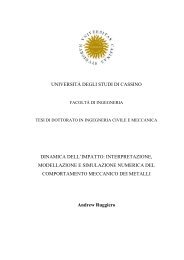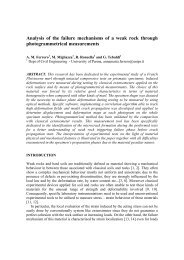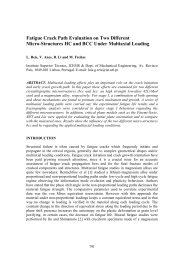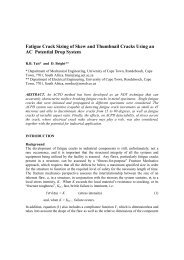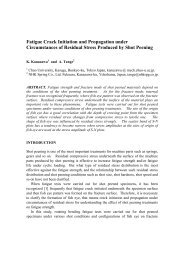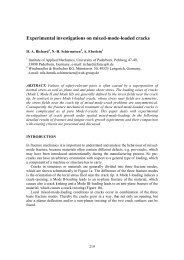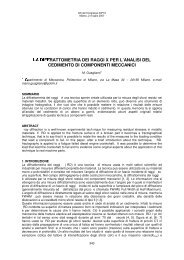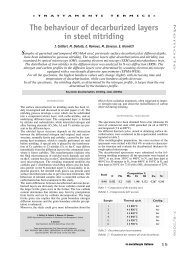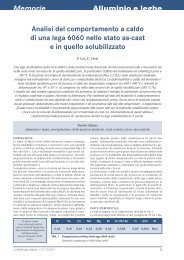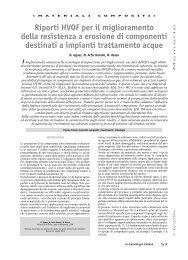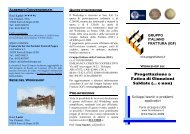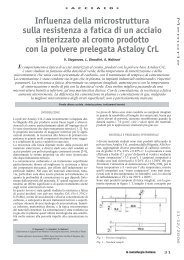Eliminazione del rischio da cromo esavalente nei refrattari esausti ...
Eliminazione del rischio da cromo esavalente nei refrattari esausti ...
Eliminazione del rischio da cromo esavalente nei refrattari esausti ...
Create successful ePaper yourself
Turn your PDF publications into a flip-book with our unique Google optimized e-Paper software.
11-12/2004 Memorie<br />
4<br />
METALLURGIA FISICA<br />
Fig. 5 – Calculated Au-Fe phase diagram: stable (Au)/Fe solvus<br />
bcc<br />
(solid line) and metastable (Au)/Fe solvus (<strong>da</strong>shed line).<br />
fcc<br />
Experimental <strong>da</strong>ta from annealing of rapidly solidified Au Fe 70 30<br />
alloy (circles) and from literature (squares).<br />
Fig. 5 - Diagramma di fase Au-Fe calcolato: solvus (Au)/Fe di bcc<br />
equilibrio (linea continua) e solvus (Au)/Fe metastabile (linea<br />
fcc<br />
punteggiata). I <strong>da</strong>ti sperimentali si riferiscono a campioni di una<br />
lega Au Fe ottenuta per rapi<strong>da</strong> solidificazione e<br />
70 30<br />
successivamente trattata termicamente a diverse temperature<br />
(cerchi) e a <strong>da</strong>ti ottenuti <strong>da</strong>lla letteratura (quadrati).<br />
Fig. 6 – Calculated metastable Ti-Cu phase diagram and T 0<br />
curves for bcc (<strong>da</strong>sh-dotted lines) and fcc (<strong>da</strong>shed lines) solid<br />
solutions. Thin continuous line represents T K .<br />
Fig. 6 – Diagramma metastabile Ti-Cu (linee continue) e curve T 0<br />
calcolate per le soluzioni solide bcc (linee tratteggiatepunteggiate)<br />
e fcc (linee tratteggiate). La linea continua sottile<br />
rappresenta la temperatura di transizione vetrosa, T K .<br />
about 5 K is sufficient. Rapid solidification of steels with higher<br />
Ni content (mode C) allows the formation of ferrite in<br />
undercooling conditions, so that austenite is produced from<br />
solid state transformation, reducing volume contraction and<br />
surface cracks formation [12]. A further increase of Ni content<br />
in the steel gives solidification mode D, so that austenite<br />
is formed directly from the melt with a primary reaction.<br />
EXTENDED SOLID SOLUTIONS IN Au-Fe [13]<br />
An interesting magnetic property, known as giant magnetoresistance<br />
(GMR), can occur when homogeneous nanosized<br />
particles of a ferromagnetic metal (for instance Fe and Co)<br />
are embedded in a paramagnetic matrix (for instance Cu<br />
and Au). This microstructure can be obtained with suitable<br />
la metallurgia italiana<br />
thermal treatments of a supersaturated solid solution obtained<br />
by rapid solidification. Good candi<strong>da</strong>tes for such behaviour<br />
are systems partially immiscible in the solid state,<br />
which are forced into solid solution by rapid solidification.<br />
Supersaturated solid solutions have been prepared by rapid<br />
solidification in the Au-Fe system [13]. X-ray diffraction<br />
analysis showed that rapidly solidified Au 70 Fe 30 consists of a<br />
single supersaturated solid solution of Fe in Au. In fact, a<br />
small liquid undercooling suffices to reach the T0 curve,<br />
where the liquid phase is partition-less transformed into a<br />
solid solution. After annealing in the temperature range<br />
between 320 °C and 500 °C, X-ray diffraction peaks showed<br />
significant broadening due to the simultaneous effect of crystallite<br />
size and lattice strain. In addition, peaks are shifted<br />
to lower angles on account of the increased lattice parameter<br />
of the supersaturated solid solution. The results suggest the<br />
occurrence of a discontinuous precipitation reaction of a Ferich<br />
fcc phase, which leaves an Au-enriched residual matrix.<br />
The composition of solid solutions obtained by XRD analysis<br />
of samples annealed until precipitation occurred at various<br />
temperatures are reported on the phase diagram shown<br />
in figure 5, together with stable bcc and metastable fcc solvus<br />
lines calculated from recent CALPHAD assessment<br />
[14]. After precipitation, compositions of the residual matrix<br />
are below the stable solvus line, which refers to the precipitation<br />
of a bcc Fe-rich phase, but are closer to the metastable<br />
solvus line calculated considering the formation of a Fe-rich<br />
fcc phase, in agreement with experimental findings.<br />
METALLIC GLASSES IN Cu-Ti [15]AND Al-Ti [16]<br />
The Cu-Ti phase diagram is characterized by several deep<br />
eutectics, so it is expected glass formation is feasible in a<br />
wide composition range [17]. The liquid shows a substantial<br />
degree of order, as put in evidence by experimental values<br />
of its excess specific heat [15]. The ordering effect in liquid<br />
alloys is generally composition dependent and the thermodynamic<br />
evidence of ordering is in agreement with direct<br />
structural <strong>da</strong>ta [18]. The C p contribution to the free energy<br />
of the liquid in undercooling conditions becomes negligible<br />
at the ideal glass transition, T K , where the entropy of fusion<br />
of the alloy is nil [19].<br />
From the assessed thermodynamic parameters [17], the free<br />
energy of liquid and crystal phases has been obtained. Including<br />
the estimated values for the excess specific heat and<br />
neglecting the formation of intermetallic phases, a metastable<br />
phase diagram has been calculated (figure 6). From the<br />
calculated metastable phase diagram the amorphizing range<br />
limited by T 0 curves has been predicted, close to the experimental<br />
results.<br />
Amorphisation in Al-Ti is not possible by rapid solidification,<br />
but it can be achieved by direct synthesis via mechanical<br />
alloying suitable blends of the elements [16]. In order to<br />
explain this result, free energy curves have been calculated<br />
at different temperatures according to the assessment reported<br />
in ref. [20]. T 0 curves have been calculated for bcc, fcc<br />
and hcp solid solutions and the results are shown in figure 7<br />
(a), together with the equilibrium phase diagram. The curves<br />
extend in a wide composition range at high temperatures,<br />
showing that partition-less crystallisation of the liquid into<br />
solid solutions cannot be prevented during melt quenching.<br />
Since no experimental <strong>da</strong>ta are available for Al-Ti, an excess<br />
specific heat of the same order as for Cu-Ti has been considered<br />
to calculate free energy curves. It was shown that the<br />
temperature dependence of the thermodynamic properties of<br />
the liquid leads to an inversion of stability of the phases at<br />
low temperature. The free energy of the liquid becomes<br />
lower than that of the solid solutions and a glass forming<br />
range is predicted. In fact, considering the excess specific



